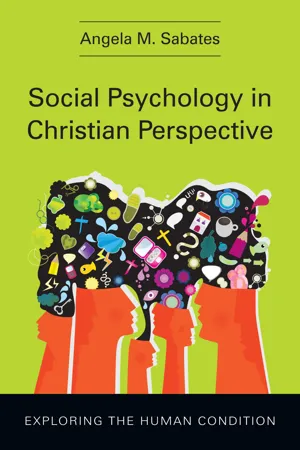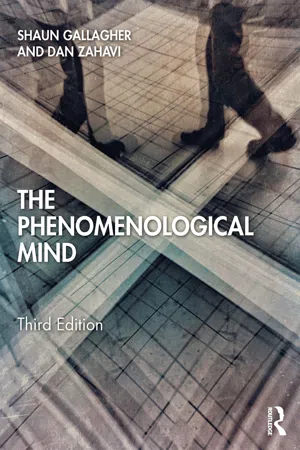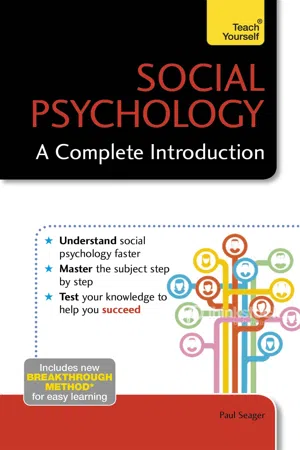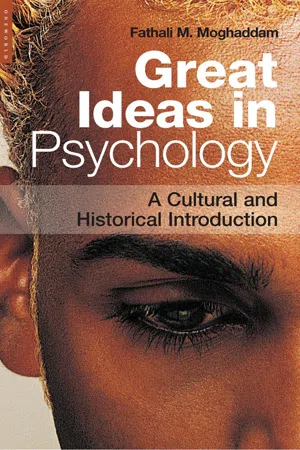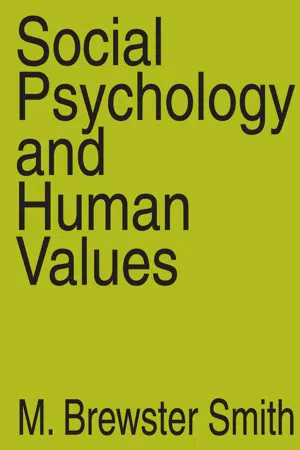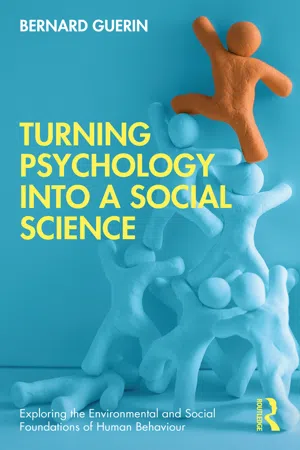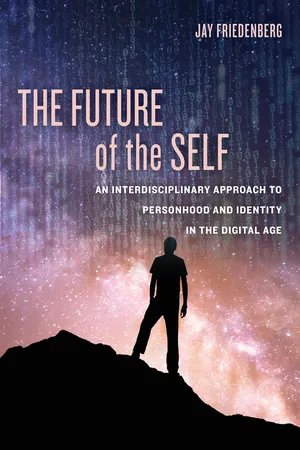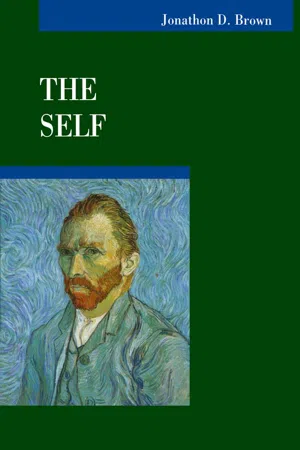Psychology
The Self
The self refers to an individual's sense of personal identity and awareness of their own existence. It encompasses one's thoughts, feelings, beliefs, and experiences, shaping their understanding of themselves and their place in the world. The concept of the self is central to understanding human behavior, cognition, and emotions.
Written by Perlego with AI-assistance
Related key terms
10 Key excerpts on "The Self"
- eBook - ePub
Mindfulness-Informed Relational Psychotherapy and Psychoanalysis
Inquiring Deeply
- Marjorie Schuman(Author)
- 2016(Publication Date)
- Routledge(Publisher)
psychological self can be defined most simply as the subjective sense of who I am. It is the center of subjectivity, inclusive of personality, thoughts, beliefs, motivations, and emotions.Although each moment of subjective experience is a one-of-a-kind constellation of sensations, thoughts, and feelings, through the repetition of many such moments, the psychological self comes to be known to itself in a way that is unique for each person. Part of the essential meaning of “self” is the sense of continuity in the ongoing stream of subjective experience, which gets narrated in language.2 ,3 It is what is referenced by the personal pronoun “I” in the elaboration of autobiographical memory.Contrary to the commonsense assumption that there is a singular psychological self, subjectivity is in fact multifaceted; there are many different aspects of self. In place of a unified and reified concept of “self,” psychoanalytic theory highlights several ideas about self. First, there is a multiplicity of selves, functionally organized. As we interact with others, we form concepts of ourselves,self-representations, and we identify with these; these concepts are who we take ourselves to be. But self needs to be understood as more than a set of concepts. It is better conceived (as it is in contemporary psychoanalysis) as a set of functions , independent of content and grounded in self-reflective awareness (Mitchell, 1993, 2000). These ideas will be elaborated in the discussion that follows. The major point here is that there are many different facets of subjectivity that must be functionally integrated in order to create the more or less cohesive experience that is referenced in common parlance by the word “self.”Different organizations of subjective experience contribute to the way we know ourselves. Different selves, configurations of self, are called forth by different circumstances, emotions, or relationships; yet, despite these differences, it is unusual for any of them to function totally outside of the sense of “me-ness.” - eBook - ePub
Christian Association for Psychological Studies Books
Exploring the Human Condition
- Angela M. Sabates(Author)
- 2012(Publication Date)
- IVP Academic(Publisher)
interpersonal level of behavior, include a chapter on The Self toward the beginning of the text. Nevertheless, beginning with a closer look at the different aspects of The Self actually makes sense. For example, since social behavior could arguably be described as the interaction among and between different collections of selves, then understanding more about this concept would be especially important. For one thing, it could reveal a lot about the human condition and how it is expressed in social interaction. In addition, knowledge of The Self can help us better understand its relationship to all of the other social psychological concepts such as group influence, social perception, helping and others that will be discussed in later chapters.From the perspective that all individuals were created in God’s image, The Self constitutes an important part of our created being. This area of research, then, can help us explore the complexity of the human condition, including its potential for both self-centered and other-centered motives.It is important to remember that the different concepts in social psychology (group influence, persuasion, etc.) are ultimately all interrelated and their effects are reciprocal. Thus, having a separate chapter on The Self is not meant to obscure the relationship of the individual with the social context. This point will be clearer once you begin to understand more fully the role of The Self in the various aspects of social functioning as you go through the text.As Leary (2007) notes, social psychology research on The Self has been quite broad, encompassing different emphases ranging from concepts related to self-perception to concepts related to emotional processes such as self-esteem enhancement and self-conscious motives. In general, regardless of the research focus, the questions mostly emphasize understanding how social interactions help define, develop and alter The Self and how The Self is motivated in light of those relationships. As with all of the concepts studied by social psychologists, the various questions regarding The Self are interrelated. - eBook - ePub
- Shaun Gallagher, Dan Zahavi(Authors)
- 2020(Publication Date)
- Routledge(Publisher)
The scientific community is rather split on the issue concerning the scientific and philosophical legitimacy of the notion of self. There is currently no consensus about whether The Self has an experiential reality or whether it is nothing but a theoretical fiction. Some claim that the sense of self is an integral part of consciousness (see Damasio 1999) and that this is something which the ongoing search for the neural correlates of consciousness must necessarily take into account. Others argue that it is neither necessary nor rational to assume the existence of a self, since it is a theoretical entity that fulfils no indispensable explanatory function (see Metzinger 2003). Currently, both sides have ardent defenders. Where should one start, if one wants to make headway?A first step is to recognize that there is no widespread philosophical consensus about what exactly it means to be a self. The concept is characterized in a variety of ways throughout the literature. The disparity of conceptions can be glimpsed by considering an incomplete inventory of terms that have come to proliferate in philosophical and psychological accounts:- Material self, social self, spiritual self (James 1890/1950).
- Ecological self, interpersonal self, extended self, private self, conceptual self (Neisser 1988).
- Autobiographical self, cognitive self, contextualized self, core self, dialogical self, embodied self, empirical self, fictional self, minimal self, neural self (see, for example, Damasio 1999; G. Strawson 1999).
This plurality, which is both problematic and productive, is directly related to the variety of methodological approaches taken within philosophy and in related interdisciplinary studies of The Self. They include introspection, phenomenological analysis, linguistic analysis, the use of thought experiments, empirical research in cognitive and brain sciences, and studies of exceptional and pathological behavior. One problem to be posed in this light is whether different characterizations of self signify diverse aspects of a unitary concept of selfhood, or whether they pick out different and unrelated concepts. This problem of “inter-theoretical coherency” is addressed below. Regardless of how one answers this problem, however, the variety of approaches and definitions found in studies of The Self productively reinforces the idea that human cognition involves complex and varied aspects that are not easily reducible to one set of principles.NEUROSKEPTICISM AND THE NO-SELF DOCTRINE
The legitimacy of the notion of self has been questioned throughout the history of philosophy. In one tradition, the claim has been that the positing of a conscious self or subject is descriptively unwarranted. If we describe the content of our consciousness accurately, if we actually pay attention to what is given, we do not find any self. This is the standard interpretation of Hume’s reflections on The Self.1 If this view is correct, it follows that, rather than having experiential reality, The Self must be classified as a linguistic construct or as a product of reflection. This is also—perhaps somewhat surprisingly—a view one can find in phenomenology. In the first edition of Logical Investigations - Paul Seager(Author)
- 2014(Publication Date)
- Teach Yourself(Publisher)
Self-esteem refers to an individual’s subjective evaluation of themselves in terms of positivity or negativity. How an individual feels about themselves can have a profound effect on how they function psychologically. Self-esteem can also be used as a measure of how an individual feels they are doing in the eyes of others. As with other aspects of The Self, it can vary across time and context.
Self-esteem refers to an individual’s subjective assessment of themselves in terms of their own qualities. It is seen as a vital component in the psychological well-being of a person.Key idea: Self-esteemThe development of self-esteem is thought to originate to some extent from the parenting style to which an individual is subjected as a child. An authoritative parenting style, which is characterized by showing strict control over the child whilst being warm and supportive, is more likely to lead to higher levels of self-esteem than children subjected to either an authoritarian (strict control but lacking in support) or permissive (lacking in control but more supportive) parenting style.(Abraham Tesser, 2001, p. 479)‘Arguably, the most important thing in one’s life is The Self. Given the importance of evaluative responding, it is no wonder then that the evaluation of self, or self-esteem, is a topic that has occupied social psychologists almost from the beginning of the discipline in its present form …’Self-esteem can be measured either explicitly through the use of questionnaires, or implicitly, through response time measures (see Spotlight below). Additionally it has been proposed that while measures, such as that of Rosenberg, assess general levels of self-esteem of an individual (trait self-esteem), it may also vary according to the situation in which an individual finds themselves (state self-esteem- eBook - ePub
Great Ideas in Psychology
A Cultural and Historical Introduction
- Fathali M. Moghaddam(Author)
- 2013(Publication Date)
- Oneworld Publications(Publisher)
More broadly, the return of The Self to mainstream psychology owes to complex cultural movements. For example, baby-boomers have been known as the “me generation” and it is not coincidental that the focus on The Self arose at a time when baby-boomers in Western academia reached middle age and became particularly influential as researchers and professors. Another factor influencing the increased focus on The Self has been the widespread political debate about The Self-esteem of women, ethnic minorities, seniors, and other power minorities. Associated with these trends has been a rise in interest not only in The Self in psychology but also in autobiography in literature. Since the 1980s in particular the bestseller lists on both sides of the Atlantic have been amply populated by autobiographies in which individuals self-reflect and self-analyze in a “tell all” fashion. There are no signs of the interest in The Self abating. Indeed, the idea of The Self remains important and central to psychology, and surely this is how it should be. One important reason is that The Self is the reference point of all our experiences, and this is important for cognition. For example, we remember things better when we relate them back to The Self – as students well know, because a lot of them use this “self-referencing” strategy to remember material in tests. New brain-imaging technologies may well lead to even greater focus on The Self, as researchers explore the parts of the brain that are activated in association with different types of self-reflection.But is The Self a great idea, or were the behaviorists right in insisting that The Self (and other such topics) be excluded from the science of psychology? Is it possible for researchers studying The Self to work in, or must they always rely on working out and developing ideas independent of empirical evidence? Are there restrictions on how The Self can be constructed, or are there limits to the degrees of freedom in this realm? Let us begin by considering the sense of self, then discuss self-perception and self-presentation. At each step it becomes apparent that, although some very innovative experimental studies have been conducted regarding The Self, major conceptual puzzles remain.THE SENSE OF SELF
Are we born with a sense of self, or does a sense of self develop within us over time? In exploring the developmental aspects of the sense of self, an intriguing discovery was made when researchers placed a red dot on the noses of infants and then placed mirrors in front of the infants. Human infants eighteen months and older touched the red spot on their noses (the only other creatures capable of this feat are the great apes), and this was taken as a sign that these infants recognized themselves in the mirror. Received wisdom informs us that this research shows the sense of self develops at around eighteen months in humans. When they are younger than this age, infants fail to touch the red dot on their noses when they look into the mirror, and this is taken to mean that they fail to see that “it is me with the red dot on my nose in the mirror.” But there are reasons why one might question this interpretation. - eBook - ePub
Person-Centred Therapy
A Clinical Philosophy
- Keith Tudor, Mike Worrall(Authors)
- 2006(Publication Date)
- Routledge(Publisher)
Throughout life, relationships and experiences can either enhance or impede the repair or further development of different aspects of the sense of self. Stern proposes an account, based on an organising principle which concerns the subjective sense of self in relation to self-and-other, comprising four senses of self and domains of relatedness which build one upon the other. Whilst he suggests (1985, p. 32) that there are formative phases in the development of self up to and around fifteen months, ‘once formed, the domains remain forever as distinct forms of experiencing social life and The Self. None are [sic] lost to adult experience’. The Self in person-centred literature Against this psychological history of self, in this part of the chapter we consider, in chronological order, a number of different theoretical views of self found in person-centred literature. Self-concept as a cognitive structure Cartwright and Graham (1984) consider The Self-concept as a structure of cognitions about The Self in which there is a hierarchy of categories based on decreasing levels of generality. Thus, they argue, ‘I am different from others’ is the highest category of generality. Other beliefs such as ‘I can’t decide’ or ‘I don’t face things’ represent less general categories. Each of these will be based on the evidence of experience. A childhood experience of not being able to choose, for example, might lead to the first of these beliefs, and an experience of being allowed to stay off school when things were difficult might lead to the second. Social, personal – and reflexive – selves As we have seen, the notion that The Self is essentially and developmentally social has its origins in the work of James and Mead. James first distinguished between ‘I’ (self as knower) and ‘me’ (self as known) - eBook - ePub
- M. Brewster Smith(Author)
- 2017(Publication Date)
- Routledge(Publisher)
identifying self-reports with constructs is sure to lead to confusion.Within the sphere of The Self concept, a further minimal distinction will probably turn out to be necessary, though I will not put it to use here. One can probably distinguish a core of identity beliefs that have persisting trans-situational relevance for a person’s view of himself (these varying in centrality or importance and saliency—thus sex vs. eye color) from the set of subidentities that correspond to William James’ notion (1890, pp. 293-296) of the person’s multiple social selves, systems of beliefs that are bound to the major distinguishable contexts of role relations in which the person participates. One may expect pronounced individual and societal variation in the extent to which such subidentities are differentiated from one another and from core identity.1The psychoanalytic tradition suggests the relevance of additional distinctions, which are introduced here not because I intend to use them directly, but to suggest the absurdity of treating the self concept as a concrete entity. We may infer that a person entertains views of himself that he fears or disavows, “negative identities” that may not be accessible to self-report; he also has conceptions of himself as he would like to be (research has picked up the latter theme for emphasis). In the sphere of percepts, he may reject self-regarding experiences as ’ego’-alien, as not pertaining to the acknowledged self.With this sketchy foundation, we can return to the task at hand. In order to consider what The Self has to do with trends toward consistency, we can begin by noting, with Lecky (1945), the importance of such trends in the very constitution of The Self. As consistency theories become more mature, we can expect that one important direction in which social psychology may seek integration with personality theory is in further specifying the role of consistency-directed processes in the formation and development of The Self. Pending such an elaboration and application of formal theory, several things can be said. - eBook - ePub
- Bernard Guerin(Author)
- 2020(Publication Date)
- Routledge(Publisher)
5 Self, identity, consciousness, and meaning as social actions in contextContextualizing the ‘self’
When someone tells me about their self, their self-image, their identity, or how they see themselves, they have already told me all about the social relationships and resources in their world—even when they tell me that they do not have a ‘self-image’ at all.There are two parts of self-identity from a contextual analysis: what a person does , performs, and has accomplished, and how a person talks about themselves (and this includes thinking of course; see V4). These two can potentially have little or nothing to do with one another, but both are intricately bound up in our social and cultural contexts and how we obtain and manage our resource–social relationship pathways. You cannot make up the first, what you have done, but you can make up talking about it—I might never have played sport but can still talk about myself as a ‘sportsperson’—however, such fictitious talk still comes from my social and cultural contexts.This means that most (but not all) about our self or identity is constructed primarily with language use, to portray ourselves in certain ways to gain resources or relationships (or lose resources as well of course). Identity is how we talk to people about ourselves and present ourselves to others, and this will usually include what we have done or accomplished. But this is not done for fun (although it can be fun) but is strategic, to position ourselves for making our lives actually work—to get the resources and social relationships we need or want for ourselves and our families and communities.Unfortunately, ‘self’ as an everyday way of talking about ourselves has been appropriated by psychological theories (one of the three responses to Gestalt; V4.1), including Freud’s ‘ego’. These theories all purport that our inner self or ego makes us do what we do , as if it is a cause or a driving force. Contextually, however, whatever life resource–social relationship pathways have been shaped for us, they have shaped both - eBook - ePub
The Future of the Self
An Interdisciplinary Approach to Personhood and Identity in the Digital Age
- Jay Friedenberg(Author)
- 2020(Publication Date)
- University of California Press(Publisher)
Finally we can turn to our controlled and out-of-control selves. Normally we regulate our behavior. This self-regulating function in Freudian psychodynamic theory is the ego, which is rational and balances the needs of the id and superego. If we completely give in to our base emotional desires, then we are acting in an out-of-control manner. Sometimes adolescents will post an inappropriate photo of themselves naked or partying because they thought it was funny or cool at the time but later will regret it. Even so-called mature adults have done this. A case in point is the politician Anthony Wiener, who for months carried on an online sexual relationship with a fifteen-year-old high school girl, sending her pictures of himself without clothes on and pressing her to engage in “rape fantasies.” We should remember that pretty much all of what we do online, including our search histories, is recorded and preserved indefinitely on computer servers in “the cloud.”Evaluating Psychological Theories of Self
We’ve covered a lot of different theories so far. Although these theories differ, there are also some common threads. Most posit the existence of multiple types of self within a single individual. These selves can take many forms. They can be internal representations of one’s self, typically posited as the ego. They can also be representations of other people, of our base “animal” natures, of our conscience or ethical sense, or of different traits we have within us. Some of the theories specify how these selves interact. In some cases they fight one another for dominance; in others they can work together toward improving and self-actualizing.Another common theme that runs through these theories is the role that the person or the environment has in influencing The Self. If the person has more influence, then their thoughts or cognitions are emphasized. If the environment has more influence, then what is salient is the social realm, the thoughts and actions of others. Modernists argue for the former, postmodernists for the latter. Social-cognitive theories combine these two and specify ways in which individual and social factors together affect behaviors, which in turn affect the environment. Many of these selves will reappear in various guises in later chapters. - eBook - ePub
- Jonathon Brown(Author)
- 2014(Publication Date)
- Psychology Press(Publisher)
special For example, it is easily noticed and well remembered. In the third part of this chapter, we will consider why this is so and examine how motivational forces and cognitive processes combine to influence the processing of personal information.THE REPRESENTATION OF SELF-KNOWLEDGE
Cognitive psychologists assume our knowledge of the world is organized into cognitive structures. Although there is disagreement about the precise form these structures take, one possibility is that knowledge is organized in a hierarchical fashion. A general concept sits at the top of the hierarchy, and more specific knowledge occupies a subordinate status.The top half of Figure 5.1 presents a greatly simplified example of this type of model for the general concept of “animal/’ Various kinds of animals are associated with this general heading (e.g., birds, fish, and mammals). Examples of each type of animal reside at a subordinate level, and linked to each of these specific animals are characteristic behaviors and attributes.People’s ideas about themselves may be represented in a similar manner (Kihlstrom & Cantor, 1984). The bottom half of Figure 5.1 shows such a model (again, very simplified). At the top of the hierarchy is The Self. Underlying this concept are three more specific headings: physical attributes, self- esteem, and social identities. Under each of the social identities are various characteristics and traits.Although not all psychologists endorse the particular model shown in Figure 5.1 , most agree that people’s ideas about themselves form a complex and highly organized knowledge structure, and that this structure becomes increasingly differentiated with age as people acquire additional knowledge of themselves. There is also agreement on the general implications of the model (Greenwald & Pratkanis, 1984; Linville & Carlston, 1994; Markus & Wurf, . For example, note the contextual basis of self-knowledge. How we think of ourselves depends on the social context (James, 1890; Rosenberg & Gara,. A person might think of himself as intelligent at school, irreverent when he’s with his friends, and responsible when he’s at work. Another thing to notice is that people have knowledge of themselves that is somewhat contradictory. For example, we might think of ourselves as serious at school, carefree with our friends, and diligent when we are working. Finally, people have views of themselves that are common to more than one role, relationship, or situation. “Honest” is such a trait in the example shown in Figure 5.1
Index pages curate the most relevant extracts from our library of academic textbooks. They’ve been created using an in-house natural language model (NLM), each adding context and meaning to key research topics.

